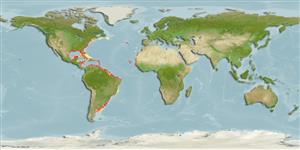Environment: milieu / climate zone / depth range / distribution range
Écologie
marin; saumâtre benthopélagique; profondeur 0 - 55 m (Ref. 26912). Subtropical; 46°N - 45°S, 98°W - 16°W
Western Atlantic: Nova Scotia, Canada through most of the West Indies; along coasts of Gulf of Mexico and South America (Ref. 26938) to Mar del Plata, Argentina. Absent from the Bahamas (Ref. 26938). Replaced by Selene dorsalis in the eastern Atlantic. These two species have not been adequately studied and may prove to be conspecific. Known to occur in Mauritania (Ref. 5377).
Length at first maturity / Taille / Poids / Âge
Maturity: Lm 20.5 range ? - ? cm
Max length : 60.0 cm TL mâle / non sexé; (Ref. 26340); common length : 25.0 cm TL mâle / non sexé; (Ref. 5217); poids max. publié: 4.6 kg (Ref. 26340)
Épines dorsales (Total): 9; Rayons mous dorsaux (Total): 21; Épines anales 3; Rayons mous anaux: 17. Pelvic fin small (Ref. 13608). A very deep-bodied, short and strongly compressed fish. Facial profile nearly vertical and concave. Pelvic fin very short (Ref. 26938).
Adults usually found near the bottom from inshore waters to at least 54 m depth, but may form schools near the surface (Ref. 5217). Juveniles are found on muddy bottoms brackish estuaries and in coastal marine waters (Ref. 5217). Adults feed on small fishes and crustaceans. Good food fish and marketed fresh.
Life cycle and mating behavior
Maturité | Reproduction | Frai | Œufs | Fécondité | Larves
Cervigón, F., 1993. Los peces marinos de Venezuela. Volume 2. Fundación Científica Los Roques, Caracas,Venezuela. 497 p. (Ref. 9626)
Statut dans la liste rouge de l'IUCN (Ref. 130435)
Menace pour l'homme
Reports of ciguatera poisoning (Ref. 30911)
Utilisations par l'homme
Pêcheries: hautement commercial; Aquarium: Aquariums publics
Outils
Articles particuliers
Télécharger en XML
Sources Internet
Estimates based on models
Preferred temperature (Ref.
123201): 12 - 27.9, mean 24.4 °C (based on 656 cells).
Phylogenetic diversity index (Ref.
82804): PD
50 = 0.5039 [Uniqueness, from 0.5 = low to 2.0 = high].
Bayesian length-weight: a=0.01288 (0.01144 - 0.01451), b=2.95 (2.92 - 2.98), in cm total length, based on LWR estimates for this species (Ref.
93245).
Niveau trophique (Ref.
69278): 3.7 ±0.52 se; based on food items.
Generation time: 2.2 ( na - na) years. Estimated as median ln(3)/K based on 2
growth studies.
Résilience (Ref.
120179): Milieu, temps minimum de doublement de population : 1,4 à 4,4 années (tmax=4.5; assuming tm=2-3).
Prior r = 0.54, 95% CL = 0.36 - 0.81, Based on 2 stock assessments.
Fishing Vulnerability (Ref.
59153): Low to moderate vulnerability (29 of 100).
Climate Vulnerability (Ref.
125649): Moderate vulnerability (36 of 100).
Nutrients (Ref.
124155): Calcium = 72.3 [42.4, 149.2] mg/100g; Iron = 1.18 [0.66, 2.21] mg/100g; Protein = 18.5 [16.6, 20.8] %; Omega3 = 0.381 [0.226, 0.665] g/100g; Selenium = 30 [16, 56] μg/100g; VitaminA = 9.4 [3.0, 26.4] μg/100g; Zinc = 0.828 [0.587, 1.182] mg/100g (wet weight);
